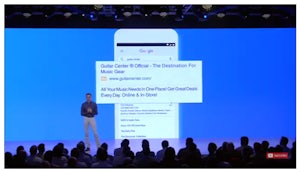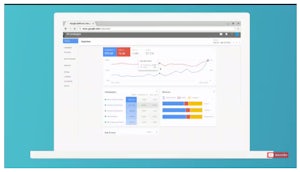Google streamed their fourth annual Performance Summit live from San Francisco this evening, unarguably the most important event of the year for AdWords users.
We never turn down an invitation. So naturally, we tuned in to get the lowdown on Google’s plans for changes and innovations on their Analytics and AdWords platforms.
What did we expect to hear?
In the lead up to the summit, Google Senior Vice President, Sridhar Ramaswamy hinted at some of the key points to be discussed (at the request of their advertisers). It’s no surprise that mobile is to dominate the discussion:
- Reaching very specific audiences for universal mobile app campaigns
- More control over creative and bidding strategies when targeting mobile devices
- Higher quality data for understanding cross-device and cross-channel customer journeys
We’ve been hearing about the grand unveiling of a massive redesign for the AdWords platform (an aesthetic update, that is) for a while now. Earlier in May, Google confirmed we’d be seeing a preview of AdWords’ overdue facelift during the summit. And the ‘big day’ didn’t disappoint…
So, let’s get to the key takeaways…
All about those ‘moments’
Bridging the gap between consumer’s intent and context was the major theme of this year’s summit.
Ramaswamy started by pointing out that in a mobile-first world, brands are presented with more ‘moments’ to connect with customers than ever before. Morning commutes on the train are now an opportunity to shop for that weekend getaway or read reviews before your next automobile purchase. For this, Google is re-imagining measurements that can bridge the online and physical world.
Mobile as a primary device is not a shift that is ‘happening’, but it has ‘happened’. Marketers are no longer wondering ‘if’ they should investing on reaching customers on mobile, but ‘how’ they can reach customers based on that all-important intent and context.
Text ads in a mobile-first world
Google is overhauling how ads will look on mobile. This update to text ads (they include the removal of right-hand column ads earlier this years, as part of this change as it allows ads to be streamlined across mobile and desktop) is the biggest update to ad creative since AdWords was launched 15 years ago.
Expect to see longer headlines and one long 80 character description line (this is almost 50% more characters for advertisers to describe their product or service). During testing, Google claims advertisers saw a 20% higher clickthrough rate when using the new ad formats.

This change will be rolled out later this year so start planning your ad content now. The advertisers that will win from this change are the ones that adapt early!
Bidding for mob-first world
“Mobile bids are not an adjustment, they are essential.” This shift to the focus on mobile means desktop will no longer lead as the default bid. There will be flexibility around bidding for each device with individual bid adjustments.
Gaining a unique understanding of intent and context will help marketers bid by device, to reach consumers during those ’momnets’ that matter the most.
Ads get (more) local
Jerry Dischler, Vice President of Search Ads gave the insight that one third of searches are related to location, suggesting marketers need to tap into those ‘I want to go’ and ‘I want to buy’ moments.
The brands that win are the ones that no longer make a divide between the digital world and the physical world. One in three people who click on a store’s search ad will then visit the physical store (75% of those visiting the same day). In a further study, store visits after a search actually out-numbered online purchases.
During trials using local inventory ads, physical stores saw a 93% increase in sales. He hinted that Google can help advertisers do this at scale, although there was no hint as to when we’ll see local inventory ads as a standard feature.
Promoted Pins & ‘Best Buy’
A feature to be trialled next year is Google’s Promoted Pins, giving the opportunity for businesses to reach customers when they’re nearby and increase foot traffic to stores.
‘Best Buy’ locations will combine shopping and maps, with the ability to search local inventories. Dischler commented that “one in four who avioid stores said it’s because they don’t know if there product will be in stock.”
This raises the question – how do we measure a journey that starts online and end in-store?
Google launched store visits tracking in December 2014 (just 1,000 businesses currently have access to this) but beacon signals will improve existing location data with incredible precision and scale, with a trial in the US seeing 200 million buildings logged. Yep, that’s right – Google will monitor what your customers are searching for and then followed their mobile device to your store using a beacon… Minds. Blown.
Unsurprisingly (considering what a huge undertaking this is), these was no hint as to when this will be rolled out as a standard feature. The future of customer journey insight looks very interesting indeed.
Similar audiences for search.
Brad Bender, Vice President of Display and Video explained this powerful yet simple idea. Reach users similar to those who have already visited your site while they are searching for your products.
In search, the users search query is the most powerful indication of intent. RLSA (remarketing lists for search ads) is already a powerful way to reach consumers who have already interacted with your website. But Similar Audiences for Search will now allow marketers to reach those who have already conducted a relevant search (similar to one conducted by someone who clicked on your ad) but haven’t yet visited your site.
Demographics for Search Ads
The age and gender targeting previously only available on display is about to become available for search campaigns too. Finally.
And what about the ‘new look’ AdWords?
Google provided insight to the aim of the redesign, which is primarily to make AdWords easier to use across all devices (there’s that mobile-focus again) with a simplified navigation. Matt Lawson, MD of Ads Marketing asked “how can we market in a mobile-first world with a platform built for desktop? The data marketers care about needs to be at their fingertips.” We hear ya’ Matt.
The Adwords platform is now 15 years old – smartphones had only existed for a year at the time of it’s launch! Continuing with the theme of the whole summit, this is all about adaption and innovation for the mobile-first world.
Paul Feng, AdWords Product Management Director (and leader of the redesign), had previously said the current navigation is ‘un-intuitive’ and comes with a ‘high learning curve’. The new AdWords interface has been built with Material Design (the design language used by Google for consumer-facing platforms such as Gmail and Google Maps) but adapted for B2B use.

So how do you get your hands on the ‘new look’ interface? Unfortunately, there will be no open beta.
Samantha Lemonnier, Director of Engineering explained that Google will be reaching out to chosen advertisers for testing with the rollout scheduled for late 2016/early 2017. Sit tight though, Google promises this ‘re-imagining of AdWords’ will be worth the wait.
You can catch up on the Google Performance Summit 2016 here.



